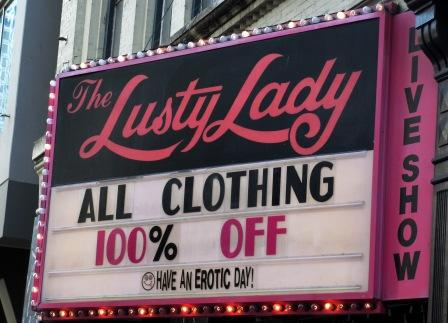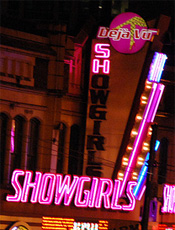We welcome this guest post from Jayne Swift, who is currently a graduate student in Cultural Studies at the University of Washington, Bothell and an employee of the Seattle Lusty Lady Theatre.
—————
In the 1970s, U.S. manufacturing jobs were decimated, with thousands of workers losing what had once been well paid and valued jobs. It was a deindustrialization crisis that would come to be remembered as a national loss. Many saw it as a sign that Americans were losing their birthright to work that is fairly compensated and  unionized; work that produces a sense of pride, identity, and community.
unionized; work that produces a sense of pride, identity, and community.
If you have spent any time within the Seattle Lusty Lady Theatre lately, you would hear similar, albeit scaled down, testimonials from Lusty Lady workers. But unlike the massive public outcry around automotive plant closings, few outside the workers of the Lusty Lady seem to care about the historical and economic impact of Lusty Lady labor.
To be sure, as Carly Chillmon mentioned in her recent post on Sexuality & Society, many DO care about the loss of the Lusty marquee. The marquee should be missed as a beacon of Seattle’s bawdy past. Yet, the public focus on the marquee also masks the reality of actual people labouring and loving inside. For almost three decades, the Lusty Lady was more than a job to countless employees—it was our GM plant, our place.

I have known I wanted a place in the Lusty Lady world for a very long time. When I was 17 and first saw the Lusty Lady while on vacation in Seattle, I was enthralled by the robed women standing outside, smoking, talking to each other, seemingly unmoved by the (potentially hostile) stares of passers-by. I wanted to know more about this place and these women.
Shortly thereafter I realized I had already knew something about this place and these women. I grew up in a feminist-intellectual home and was an avid consumer of texts that explored questions of feminism, gender, and sexuality. In particular, I sought to understand the feminist sex wars and the fierce battles over pornography and prostitution they engendered.
Like many of my “third wave feminist” ilk, I discovered a burgeoning field of literature that articulated what might be called a “sex-positive” vision of sex work; anthologies that featured the voices of sex workers discussing their work on their terms. The Lusty Lady was a recurring feature in many of these texts—used as a site for sex workers to think through the value of their work, articulate experiences of sex work not often validated in the larger world, and sometimes organize to serve their own best interests as workers and people. Indeed, a cursory look at U.S. sex worker literature[i] reveals the Lusty’s significance to the growth of the contemporary sex worker rights movement. The battles to unionize the San Francisco branch of the Lusty (dramatized in the 2000 film Live Nude Girls Unite!). the memoirs published by Lusty workers, and the uniquely female management made the Lusty Lady a rich site for theorizing commercial sex cultures and producing a sex worker feminism.

Throughout my undergraduate years I studied the Lusty from afar as something akin to a feminist destination, something I might do with my education and training in Gender/Sexuality Studies. After finishing my M.A. in Women’s Studies at the University of Iowa I moved to Seattle and got up the courage to pursue what, quite simply, had become my dream of working at the Lusty Lady.
For the last several years that dream has structured and animated my life. Like all jobs the Lusty involves its share of drudgery, and more than many jobs a host of emotional and physical challenges. Yet, unlike a lot of other jobs I’ve held (in and out of the sex industry) the Lusty has consistently demanded that I grow on an embodied ethical and intellectual level. The Lusty is the space in which I was able to claim the term sex worker and feel prepared to defend my worth. Every day at the Lusty presented an opportunity to reflect upon some of my central intellectual preoccupations, including: the performativity of gender, theories of objectification, feminist agency and resistance, the production of desire and power, queer theory, the intersections of labor, feminist, and local history and struggle.
It might seem odd to some, but the Lusty made me a better thinker and scholar. Perhaps just as important, the Lusty also forced me to examine and change myself on a more grounded, personal level.
At the Lusty, I learned that there were all kinds of beautiful bodies and personas. I learned that being desired and being able to desire are not contingent upon achieving a pernicious beauty standard. The Lusty taught me—in a way that no therapy or degree could—that my body was mine and I had better find a way to feel good and strong in it in order to survive. In doing so, the Lusty also taught me to look customers, men, in the eye and find a way to show up to their desires and needs when they asked for them respectfully—and stand up to them when I was disrespected. The Lusty reaffirmed my commitment to honoring other people’s erotic selves and gave me a tangible venue in which to perform that commitment. The Lusty taught me that one’s work could be good for others as well as me, that I had a right to be treated fairly and respected, and that I need to pursue the respect I want. Perhaps most importantly, the Lusty challenged me to reconceive of and enact the thing that feminists once called “sisterhood.”
My Lusty sisterhood grew not out of consciousness raising groups but out of my grounded working conditions: the Lusty required employees to find ways to work alongside each other, often across multiple lines of social difference. The physical and social structure of the business, instead of breeding the competition found in many other legal sex businesses, inculcated workers with a sense of collectivity and common purpose. As my co-worker Wildflower puts it,
“much like a contrived women’s support group…we share the most tender and raunchy parts of ourselves. Something about being naked, playing a role and entertaining the gents keeps things light enough to share some heavy challenges.”
Indeed, the workers of the Lusty often express a bond with each other simply due to our shared love for this place and what is has given us. My experience of the world tells me that it is rare for people to describe their workplaces in terms that another co-worker, Lux, does as the place where she “grew up”:
“It was a safe place for me to be unconditionally loved, a place where it was alright for me to be me, a place no matter what I did I would be accepted.”
Gypsy, another co-worker, reiterates this theme of kinship. For her the Lusty was the site of a unique and “incomparable connection with female co workers/”family.”
I probably could have espoused it, but until I actually became a Lusty Lady I don’t think I really understood what people—feminists often—meant when they talked about the need for sisters, allies, family.
Home, family, erotic temple, feminist teaching ground, support system, or as Lux put it, “place of belonging”—these are the organizing narratives and metaphors we (the workers) often use to describe and explain our experience of the Lusty Lady. No one is arguing that it was a perfect place; a utopia. However, many of us, myself included, are currently charged with trying to make sense of this time, place and labor we have shared with each other. We want the world to understand the Lusty’s powerful and at times beautiful resonance in our lives and our grief about its ending. The loss of this place—a local institution which employed countless people over three decades, inspired its workers, and at times brought women together in a world that often profits by driving us apart—matters, whether or not you’ve ever dared to set foot inside it.
I can only hope that when we close our doors in June we are greeted by other mourners, all those who care about sex workers, standing respectfully on the other side of the marquee.
—————————————-
Jayne Swift was lucky enough to take her first baby steps in six inch heels at the Lusty Lady theatre and is currently completing an M.A. in Cultural Studies at the University of Washington-Bothell.
Referenced and recommended works:
[i] See:Brooks, Siobhan “Dancing Towards Freedom” Whores and Other Feminists, Ed. Jill Nagle Routledge: 1997.
Dudash, Tawnya. “Peepshow Feminism,” Whores and Other Feminists, Ed. Jill Nagle Routledge: 1997.
Eaves, Elisabeth. 2002. Bare: On Women, Dancing, Sex, and Power. Knopf.
Funari, Vicky “Naked, Naughty, Nasty: Peep Show Reflections” Whores and Other Feminists, Ed. Jill Nagle Routledge: 1997.
Langley, Erika. 1997. The Lusty Lady. Scalo Zurich-Berlin-New York.
Queen, Carol. 1997. Real Live Nude Girl: Chronicles of a Sex-Positive Culture. Cleis.







 Recently I was invited to be a guest on Seattle’s NPR station, KUOW (94.9 FM). The topic: “
Recently I was invited to be a guest on Seattle’s NPR station, KUOW (94.9 FM). The topic: “